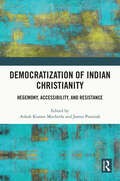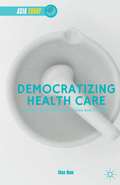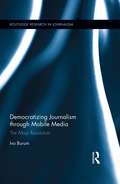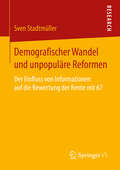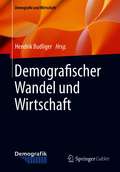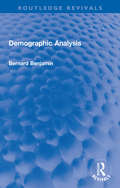- Table View
- List View
Democratization of Indian Christianity: Hegemony, Accessibility, and Resistance
by Ashok Kumar Mocherla James PonniahThis book highlights the transformative potential of democratic Church and Christian community in India. In the light of both ongoing and, also to some extent, foregone sociopolitical and theological challenges confronting Indian Christianity, this book invokes the need to democratize Indian Christianity in terms of its theology, liturgy, teachings, practices, resources, leadership roles, and institutional power relations/sharing by keeping contemporary “social realities” of Indian Christians at the core of its approach and discourse. It explores internal challenges – of caste, class, gender, and regional contestations – and external forces of communalism and majoritarianism confronting Indian Christianity today. Further, it underlines the importance of dignity, equality, fraternity, freedom, and responsibility emerging at an organizational level through strong mechanisms of deliberation, decision-making, and execution. A major contribution to religious studies in India, this book will be of great interest to scholars and researchers of religion, especially Christian theology, South Asian studies, politics, and sociology.
Democratizing China’s Political Imaginaries
by Rongxin LiThis book offers a meticulous empirical examination of Chinese democracy and its myriad discourses. Delving into the intricate workings of Chinese democracy, the author explores how the Chinese Communist Party employs democratic principles, how intellectuals grapple with the concept, and how the populace perceives and engages with democracy. In transcending mere methodological nationalism, this narrative extends to the global stage, offering insights into democratic evolution beyond Western paradigms by exploring resonates particularly with developing and post-colonial countries, offering a fresh perspective on the delicate balance between state capacity, social order, and the democratization process. While the trajectory of democracy in China remains uncertain, these empirically grounded analyses provide a pragmatic lens through which to contemplate the future of Chinese political dynamics.
Democratizing Health Care: Welfare State Building in Korea and Thailand (Asia Today)
by Illan NamThis book provides an account of milestone health insurance reforms that took place in Korea and Thailand, which significantly advanced equitable access and redistribution in health care. Thai and Korean welfare champions were deeply informed by their experiences as activists in their countries' democracy movements.
Democratizing Journalism through Mobile Media: The Mojo Revolution (Routledge Research in Journalism)
by Ivo BurumFuelled by a distrust of big media and the development of mobile technologies, the resulting convergence of journalism praxis (professional to alternative), workflows (analogue to multipoint digital) and platforms (PC to mobile), result in a 24-hour always-on content cycle. The information revolution is a paradigm shift in the way we develop and consume information, in particular the type we call news. While many see this cultural shift as ruinous, Burum sees it as an opportunity to utilize the converging information flow to create a galvanizing and common digital language across spheres of communication: community, education and mainstream media. Embracing the digital literacies researched in this book will create an information bridge with which to traverse journalism’s commercial precarity, the marginalization of some communities, and the journalism school curricula.
Democratizing Journalism through Mobile Media: The Mojo Revolution (Routledge Research in Journalism)
by Ivo BurumFuelled by a distrust of big media and the development of mobile technologies, the resulting convergence of journalism praxis (professional to alternative), workflows (analogue to multipoint digital) and platforms (PC to mobile), result in a 24-hour always-on content cycle. The information revolution is a paradigm shift in the way we develop and consume information, in particular the type we call news. While many see this cultural shift as ruinous, Burum sees it as an opportunity to utilize the converging information flow to create a galvanizing and common digital language across spheres of communication: community, education and mainstream media. Embracing the digital literacies researched in this book will create an information bridge with which to traverse journalism’s commercial precarity, the marginalization of some communities, and the journalism school curricula.
Democratizing the Enemy: The Japanese American Internment (PDF)
by Brian Masaru HayashiDuring World War II some 120,000 Japanese Americans were forcibly removed from their homes and detained in concentration camps in several states. These Japanese Americans lost millions of dollars in property and were forced to live in so-called "assembly centers" surrounded by barbed wire fences and armed sentries. In this insightful and groundbreaking work, Brian Hayashi reevaluates the three-year ordeal of interred Japanese Americans. Using previously undiscovered documents, he examines the forces behind the U.S. government's decision to establish internment camps. His conclusion: the motives of government officials and top military brass likely transcended the standard explanations of racism, wartime hysteria, and leadership failure. Among the other surprising factors that played into the decision, Hayashi writes, were land development in the American West and plans for the American occupation of Japan. What was the long-term impact of America's actions? While many historians have explored that question, Hayashi takes a fresh look at how U.S. concentration camps affected not only their victims and American civil liberties, but also people living in locations as diverse as American Indian reservations and northeast Thailand.
Democratizing the Enemy: The Japanese American Internment
by Brian Masaru HayashiDuring World War II some 120,000 Japanese Americans were forcibly removed from their homes and detained in concentration camps in several states. These Japanese Americans lost millions of dollars in property and were forced to live in so-called "assembly centers" surrounded by barbed wire fences and armed sentries. In this insightful and groundbreaking work, Brian Hayashi reevaluates the three-year ordeal of interred Japanese Americans. Using previously undiscovered documents, he examines the forces behind the U.S. government's decision to establish internment camps. His conclusion: the motives of government officials and top military brass likely transcended the standard explanations of racism, wartime hysteria, and leadership failure. Among the other surprising factors that played into the decision, Hayashi writes, were land development in the American West and plans for the American occupation of Japan. What was the long-term impact of America's actions? While many historians have explored that question, Hayashi takes a fresh look at how U.S. concentration camps affected not only their victims and American civil liberties, but also people living in locations as diverse as American Indian reservations and northeast Thailand.
Democratizing the Enemy: The Japanese American Internment
by Brian Masaru HayashiDuring World War II some 120,000 Japanese Americans were forcibly removed from their homes and detained in concentration camps in several states. These Japanese Americans lost millions of dollars in property and were forced to live in so-called "assembly centers" surrounded by barbed wire fences and armed sentries. In this insightful and groundbreaking work, Brian Hayashi reevaluates the three-year ordeal of interred Japanese Americans. Using previously undiscovered documents, he examines the forces behind the U.S. government's decision to establish internment camps. His conclusion: the motives of government officials and top military brass likely transcended the standard explanations of racism, wartime hysteria, and leadership failure. Among the other surprising factors that played into the decision, Hayashi writes, were land development in the American West and plans for the American occupation of Japan. What was the long-term impact of America's actions? While many historians have explored that question, Hayashi takes a fresh look at how U.S. concentration camps affected not only their victims and American civil liberties, but also people living in locations as diverse as American Indian reservations and northeast Thailand.
Demodiversity: Toward Post-Abyssal Democracies (Epistemologies of the South)
by Boaventura de Sousa SantosWe are living in a time when social and political authoritarianism appear to be gaining ground around the world. This book presents the democratic practices, spaces and processes that engage directly with the theoretical assumptions advanced by the epistemologies of the South, summoning other contexts and empirical realities that attest to the possibility of a renewal and deepening of democracy beyond the liberal and representative canon, which is embedded within a world capitalist system. The chapters in this book put forward the ideas of demodiversity, of high-intensity democracy, of the articulation between representative democracy and participatory democracy as well as, in certain contexts, between both these and other forms of democratic deliberation, such as the communitarian democracy of the indigenous and peasant communities of Africa, Latin America and Asia. The challenge undertaken in this book is to demand utopia, imagining a post-abyssal democracy that permits the democratizing, decolonizing, decommodifying and depatriarchalizing of social relations. This post-abyssal democracy obliges us to satisfy the maximum definition of democracy and not the minimum, transforming society into fields of democratization that permeate the structural spaces of contemporary societies.
Demodiversity: Toward Post-Abyssal Democracies (Epistemologies of the South)
by Boaventura De Sousa Santos José Manuel MendesWe are living in a time when social and political authoritarianism appear to be gaining ground around the world. This book presents the democratic practices, spaces and processes that engage directly with the theoretical assumptions advanced by the epistemologies of the South, summoning other contexts and empirical realities that attest to the possibility of a renewal and deepening of democracy beyond the liberal and representative canon, which is embedded within a world capitalist system. The chapters in this book put forward the ideas of demodiversity, of high-intensity democracy, of the articulation between representative democracy and participatory democracy as well as, in certain contexts, between both these and other forms of democratic deliberation, such as the communitarian democracy of the indigenous and peasant communities of Africa, Latin America and Asia. The challenge undertaken in this book is to demand utopia, imagining a post-abyssal democracy that permits the democratizing, decolonizing, decommodifying and depatriarchalizing of social relations. This post-abyssal democracy obliges us to satisfy the maximum definition of democracy and not the minimum, transforming society into fields of democratization that permeate the structural spaces of contemporary societies.
Demografie Exzellenz: Handlungsmaßnahmen und Best Practices zum demografieorientierten Personalmanagement
by Uwe SchirmerDas Werk vermittelt eine prägnante Einführung in die Themen demografischer Wandel und demografieorientiertes Personalmanagement und gliedert sich in sechs Teile.Ausgehend von einem kurzen Einleitungsteil zur demografischen Entwicklung und zu KMUs folgt ein Grundlagenbeitrag zum demografieorientierten Personalmanagement. Anschließend wird ein systematisches Vorgehen zur Einführung eines solchen HR-Konzeptes in Unternehmen anhand eines ganzheitlichen Gestaltungsrahmens beschrieben. Darauf aufbauend folgen Ausführungen zu ausgewählten Handlungsfeldern des demografieorientierten Personalmanagements. Der gesamte Grundlagenteil enthält eine Vielzahl konkreter Vorgehensweisen mit praxisbezogenen Einführungsinstrumenten wie Checklisten, Tools, Planungstabellen, Softwarehinweisen, Workshop-Konzeptionen usw. Im Anschluss folgt ein veranschaulichender Praxisteil mit Erfahrungsberichten aus Unternehmen, die als Best-Practice Lösungen im Rahmen des Demografie Exzellenz Awards ausgezeichnet wurden. Im letzten Teil werden die Ergebnisse der Studie „Demografie Exzellenz – Herausforderungen im Personalmanagement“ dargestellt, die einen Überblick zum Professionalisierungsstand des demografieorientierten Personalmanagements in deutschen Unternehmen geben.
Demografischer Wandel und Kultur: Veränderungen im Kulturangebot und der Kulturnachfrage
by Andrea Hausmann Jana KörnerDas Buch beschäftigt sich mit den Folgen des demografischen Wandels für Kultur, Kulturpolitik und Kulturmanagement und zeigt Chancen für die Zukunft auf. Es werden grundlegende aktuelle Entwicklungen im Spannungsfeld zwischen Demografie und Kultur sowie damit einhergehende Herausforderungen für die Kultur und die Kultureinrichtungen thematisiert. Vertreter aus Wissenschaft und Praxis beleuchten unterschiedliche Fragestellungen und zeigen Lösungsansätze auf, die sich für die kulturellen und kulturpolitischen Handlungsfelder ergeben. Hierbei geht es unter anderem um den richtigen Umgang mit den künftigen Kulturnachfragern, die Angebotsgestaltung der Zukunft und das Marketing von Kultureinrichtungen.
Demografischer Wandel und unpopuläre Reformen: Der Einfluss von Informationen auf die Bewertung der Rente mit 67
by Sven StadtmüllerSven Stadtmüller zeigt anhand von Labor- und Online-Experimenten, dass durch die Vermittlung von Informationen zum demografischen Wandel und zur Umlagefinanzierung der Rente eine positivere Einstellung zur Rente mit 67 hervorgerufen werden kann. Er führt aus, bei welchen Personengruppen Informationen besonders wirksam sind und wie diese dargeboten werden müssen, um eine günstigere öffentliche Meinung zu der Reform zu erzeugen. Grundlegend für seine Untersuchung ist seine Beobachtung, dass die demografischen Trends, die Funktionsweise des Rentensystems und die Zusammenhänge von Demografie und Alterssicherung in der Bevölkerung nicht, wie gemeinhin angenommen, jedem geläufig sind.
Demografischer Wandel und Wirtschaft (Demografie und Wirtschaft)
by Hendrik BudligerDemografie und demografischer Wandel betreffen uns alle. Dennoch ist das Thema viel zu wenig in unseren Köpfen und in der Öffentlichkeit präsent. Dieses Buch befasst sich mit den Auswirkungen des demografischen Wandels auf die Wirtschaft, wobei dies differenziert aus mehreren Perspektiven betrachtet wird. In verständlicher Sprache bieten die Autorinnen und Autoren aus Wissenschaft und Praxis fokussierte Einblicke in ihre Arbeit, um Erkenntnisse und Zusammenhänge zwischen der Demografie und der Wirtschaft zu diskutieren und um ihre jeweiligen Blickwinkel und Kompetenzen zu vermitteln. Es werden sowohl Problemfelder aufgezeigt, die erst im Entstehen sind, als auch Lösungsansätze für bereits bestehende Zusammenhänge vorgeschlagen. Neben verschiedenen Ursachen demografischen Wandels werden Auswirkungen der demografischen Entwicklung auf Nachfrage, Arbeitsmarkt, Rentenversicherung, Staatsfinanzen und den Klimawandel analysiert sowie die Covid-19-Pandemie und deren Auswirkung auf demografische Faktoren diskutiert. Dies ist der erste Band der Reihe Demografie und Wirtschaft.
Demographic Analysis (Routledge Revivals)
by Bernard BenjaminFirst published in 1968, Demographic Analysis was written to provide a comprehensive account of demographic methods for those with a need to understand population movements. The book provides an introduction to some of the key tools used by demographers and the principal sources of population data. Beginning with an overview of the scope, content and use of the population census, it then examines methods for measuring births, deaths, and migration before setting out the methodology for determining the contributions of these elements to population change and estimating past or future changes. The book also explores sickness as a population characteristic and a way of better understanding mortality variations.
Demographic Analysis (Routledge Revivals)
by Bernard BenjaminFirst published in 1968, Demographic Analysis was written to provide a comprehensive account of demographic methods for those with a need to understand population movements. The book provides an introduction to some of the key tools used by demographers and the principal sources of population data. Beginning with an overview of the scope, content and use of the population census, it then examines methods for measuring births, deaths, and migration before setting out the methodology for determining the contributions of these elements to population change and estimating past or future changes. The book also explores sickness as a population characteristic and a way of better understanding mortality variations.
Demographic Analysis: Projections on Natality, Fertility and Replacement
by Roland PressatPopulation control requires that the birth rate equal to the death rate. If it is too low population will decline; if it is too high, population will increase. If either condition persists long enough the population will diminish towards zero or increase towards infinity. Fortunately, the birth trajectory does not have to be set once and for all, but can be adjusted within limits. Since birth and death rates determine whether we are heading for population extinction or explosion, they are well designated "vital statistics." Their understanding and use are a central theme of demographic analysis."Demographic Analysis" presents those techniques that are often called for in the study of demographic problems. Such techniques permit researchers to fill the gap between the large amounts of data made available by censuses and the theoretical and practical questions that need to be answered; the techniques of this book effectively bring the data into confrontation with the problems. In his treatment of population projection, Pressat applies methods developed in earlier sections for mortality arid fertility. The emphasis is on population projection and accords with its usefulness in demographic analysis. The meaning of a demographic rate or trend is brought out by seeing to what condition it would lead if continued. No assumption is made that the concrete future will follow either path.The substance of the book is devoted to the main themes of mortality and fertility. Underlying these as well as nearly every other kind of data with which the demographer deals is the problem of location in time - the relation of vital events to the calendar, and also to the age of the persons undergoing them. Pressat's detailed attention to this problem forms a solid basis for how current methodology accounts of demographic changes.
Demographic Analysis: Projections on Natality, Fertility and Replacement
by Roland PressatPopulation control requires that the birth rate equal to the death rate. If it is too low population will decline; if it is too high, population will increase. If either condition persists long enough the population will diminish towards zero or increase towards infinity. Fortunately, the birth trajectory does not have to be set once and for all, but can be adjusted within limits. Since birth and death rates determine whether we are heading for population extinction or explosion, they are well designated "vital statistics." Their understanding and use are a central theme of demographic analysis."Demographic Analysis" presents those techniques that are often called for in the study of demographic problems. Such techniques permit researchers to fill the gap between the large amounts of data made available by censuses and the theoretical and practical questions that need to be answered; the techniques of this book effectively bring the data into confrontation with the problems. In his treatment of population projection, Pressat applies methods developed in earlier sections for mortality arid fertility. The emphasis is on population projection and accords with its usefulness in demographic analysis. The meaning of a demographic rate or trend is brought out by seeing to what condition it would lead if continued. No assumption is made that the concrete future will follow either path.The substance of the book is devoted to the main themes of mortality and fertility. Underlying these as well as nearly every other kind of data with which the demographer deals is the problem of location in time - the relation of vital events to the calendar, and also to the age of the persons undergoing them. Pressat's detailed attention to this problem forms a solid basis for how current methodology accounts of demographic changes.
Demographic Analysis of Latin American Immigrants in Spain: From Boom to Bust (Applied Demography Series #5)
by Andreu Domingo Albert Sabater Richard R. VerdugoThis book provides a unique, timely and comprehensive insight into Latin American immigrants in Spain. Each chapter uses a demographic framework to examining important topics related to the experiences of Latin American immigrants in Spain, like their rapid acquisition of nationality, their contrasting patterns of migration and settlement compared to other immigrant groups, their labour market experiences before and during the economic recession, their reproductive behaviour before and after settling in Spain, as well as the push and pull factors of what is regarded as one of the single biggest waves of international migration ever experienced by Spain.Beyond the investigation of such pertinent topics, this book addresses issues relating to the adequacy of demographic theory in explaining the presence of Latin American immigrants in Spain, particularly the trailblazing presence of women among the immigrants. Spain unquestionably constitutes a good example of the fact that the future of demographic growth in post-transitional countries is mainly and irreversibly marked by the evolution of migratory movements, while the latter factor is closely linked with the economic state of affairs. In the short term at least, the causal relations go from economy to demography. In the long term, if economic growth is linked with demographic growth as some economists hypothesise, this would also be fundamental, not only in the sense of growth itself but also with regard to how this might be distributed.
The Demographic and Development Divide in India: A District-Level Analyses
by Sanjay K. Mohanty Udaya S. Mishra Rajesh K. ChauhanThis book is the first-ever volume which provides comprehensive information on demographic, health and development at the level of 640 districts in India. Central and state governments, developmental organizations, national and international NGOs and researchers require disaggregated data at the district level for many practical purposes. However, such information is not readily available for use. The editors, with a close-knit group of collaborators, have compiled data from reliable sources for each district of India and present the results in the form of composite indexes. The chapters rank districts within the state and vis-à-vis all districts of India to help readers understand intra-district and inter-district developmental disparities. They present spatial analyses that depict clustering of development. It is a ready reference for planners, researchers and students and provides scientific analyses that depict the clustering of development parameters at the district level. This volume is meant for a wide readership interested in development in India, across population studies, sociology, economics, statistics, to regional development, and from academics, researchers, and planners to policy makers.
Demographic and Family Transition in Southeast Asia
by Wei-Jun Jean YeungThis open access book presents the trends and patterns of demographic and family changes from all eleven countries in the region for the past 50 years. The rich data are coupled with historical, cultural and policy background to facilitate an understanding of the changes that families in Southeast Asia have been going through. The book is structured into two parts. Part A includes three segments preceded by a briefing on Southeast Asia. The first segment focuses on marital and partnership status in the region, particularly marriage rates, age at marriage, incidence of singlehood, cohabitation, and divorce. The second segment focuses on fertility indicators such as fertility rates (total, age-specific, adolescent), age at childbearing, and childlessness. The third presents information on household structures in the region by examining household sizes, and incidence of one-person households, single-parent families, as well as extended and composite households. Part B presents indicators of children and youth’s well-being.
Demographic and Socioeconomic Basis of Ethnolinguistics
by Jacob S. SiegelThis book presents a description and analysis of sociolinguistics written from a demographer’s perspective. It synthesizes the data on the materials, methods, and issues of this interdisciplinary field, pulling together the scattered materials published in this area into a coherent whole. Drawing on a wide range of sciences in addition to demography and sociolinguistics, including sociology, anthropology, statistics, psychology, neuroscience, and public policy, the book treats theoretical and applied issues, links methods and substantive findings, covers both national and international materials, and provides prehistorical, historical, and contemporary illustrations. The book treats the theoretical issue of how the language we use develops socially on a base of linguistic genetic capacity and the practical issue of how the intervention of the state and public figures may profoundly alter the natural evolution of the language. As such, this book will appeal to a wide range of users, from students to teachers and practitioners of social demography, sociolinguistics, cultural anthropology, and particularly to those social scientists interested in ethnic studies and human migration.
Demographic Change and Economic Development (Studies in Contemporary Economics)
by Alois Wenig Klaus F. ZimmermannIn recent years, population economics has become increasingly popular in both economic and policy analysis. For the inquiry into the long term development of an economy, the interaction between demographic change and economic activity cannot be neglected without omitting major aspects of the problems. This volume helps to further developments in theoretical and applied demographical economics covering the issues of demographic change and economic development. The interaction between demographic change and economic development in the long run is one central issue. One conjecture is that it is mainly the relative population pressure which controls the pace of economic development. However, econometric evidence presented in the book does not support this hypothesis. Other papers deal with the relationships between fertility and business cycle fluctuations, the timing of births, the efficiency in intergenerational transfers, the role of open economies for the population issue, historical perspectives of demographic change in Hungary and an outline of recent developments of applied modelling using input-output models, programming models or econometric techniques.
Demographic Change and Economic Growth: Simulations on Growth Models (Contributions to Economics)
by Lars WeberIn this book the author investigates the impact of demographic change on economic growth. As a result of the current financial crisis, a new view on economics has been demanded by various scientists. The author provides such a new view on economic growth, using a methodology of system dynamics. By applying this method, the author focuses on characteristics of complex systems and analyzes aging and shrinking processes, and not only positive growth. Delays and feedback processes are also considered. This leads to deeper and revealing insights into economic behavior. In doing so, a new semi-endogenous growth model is developed by introducing a specific and detailed population sector (demographic growth model). The book shows and analyzes the behavior of such a model and tests several policy scenarios in a transfer chapter to apply the new theoretical approach on real world problems. The major results are summarized in 15 principles of demographic growth.
Demographic Change and Housing Wealth: Home-owners, Pensions and Asset-based Welfare in Europe
by John Doling Marja ElsingaAcross the EU, populations are shrinking and ageing. An increasing burden is being placed on a smaller working population to generate the taxes required for pensions and care costs. Welfare states are weakening in many countries and across Europe, households are being increasingly expected to plan for their retirement and future care needs within this risky environment. At the same time, the proportion of people buying their own home in most countries has risen, so that some two-thirds of European households now own their homes. Housing equity now considerably exceeds total European GDP. This book discusses questions like: to what extent might home ownership provide a potential cure for some of the consequences of ageing populations by realizing housing equity in order to meet the consumption needs of older people? What does this mean for patterns of inheritance and longer-term inequalities across Europe? And to what extent are governments banking on their citizens utilising their housing wealth now and in the future?
